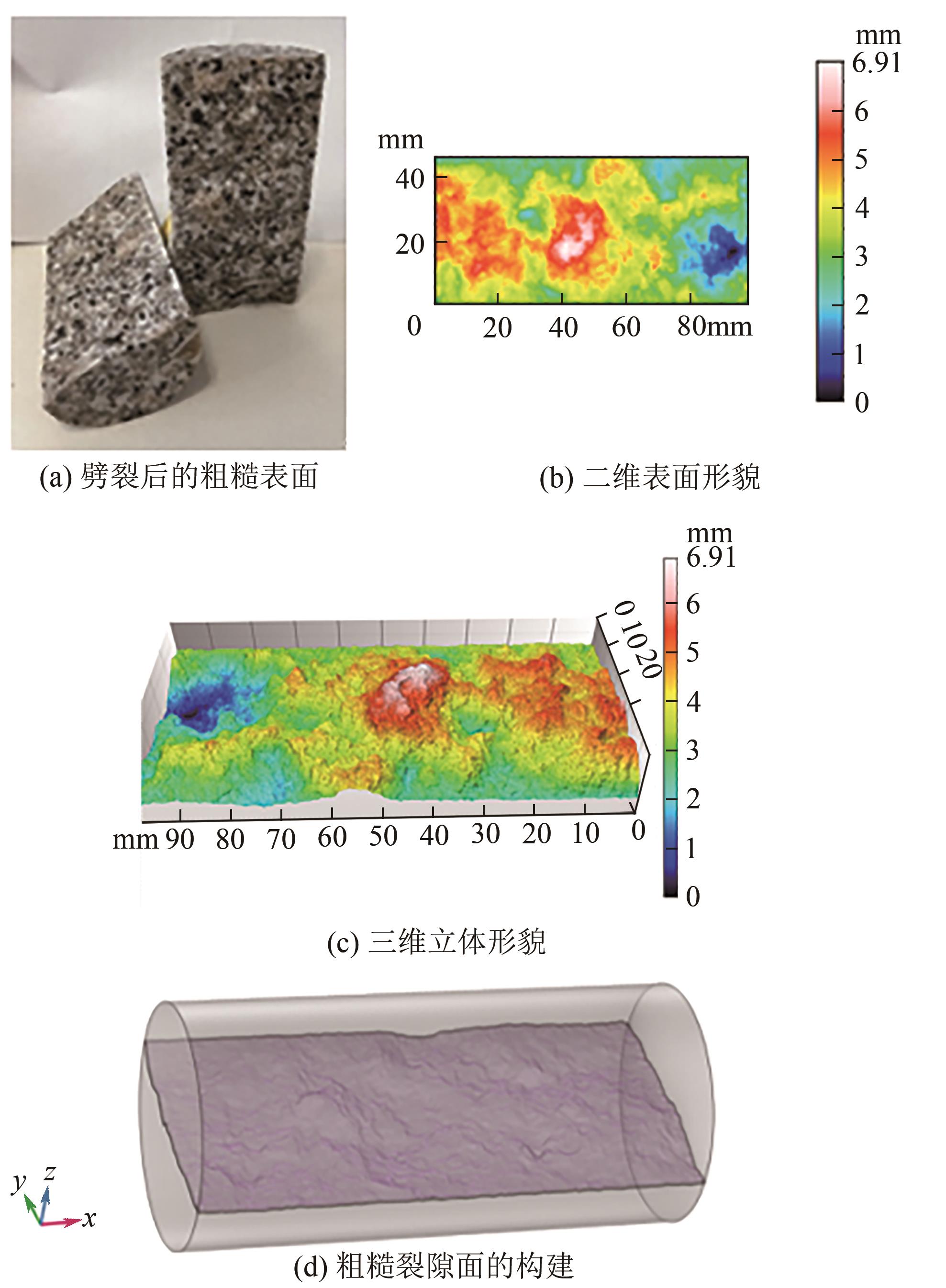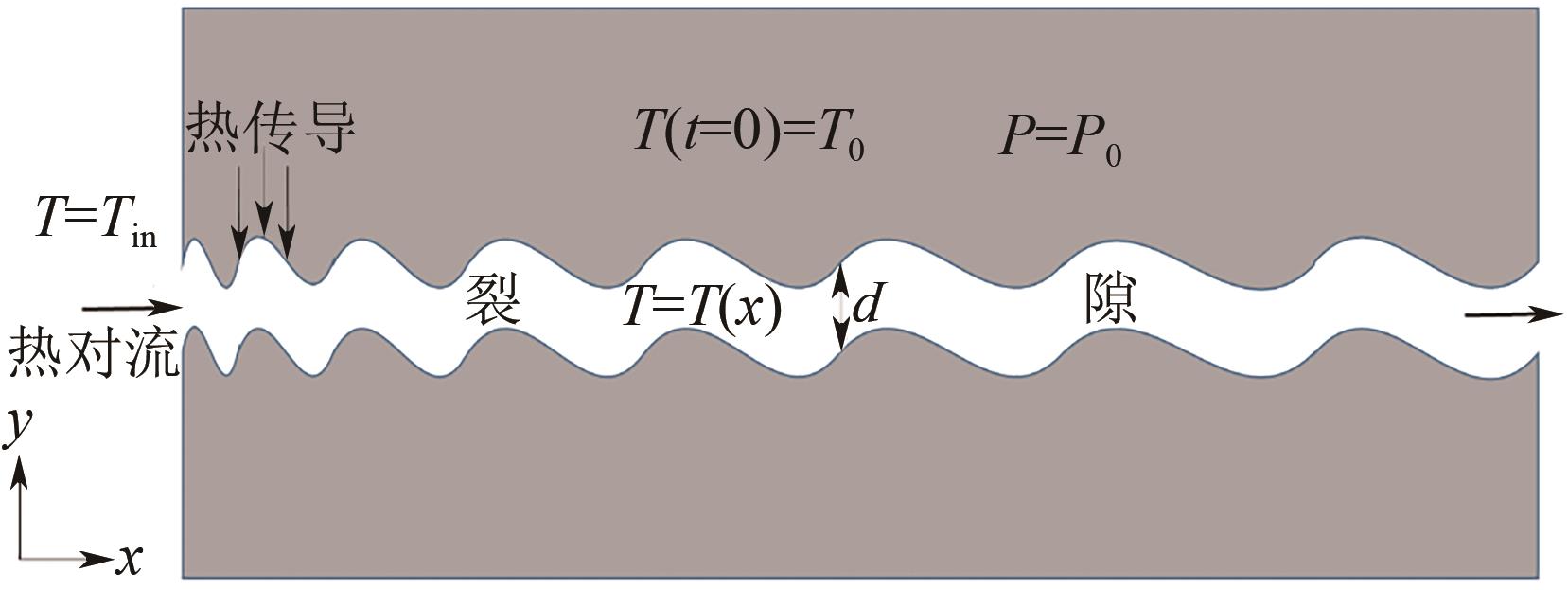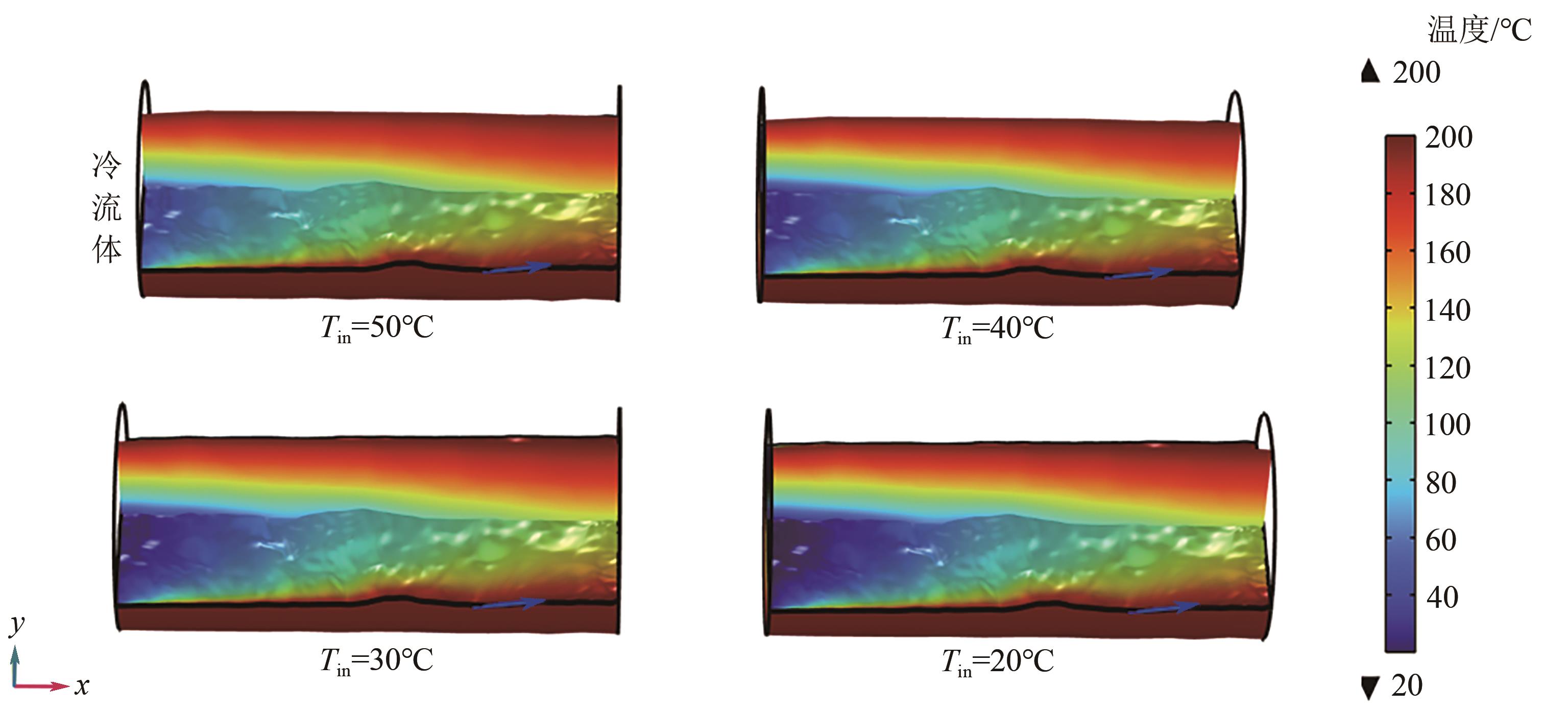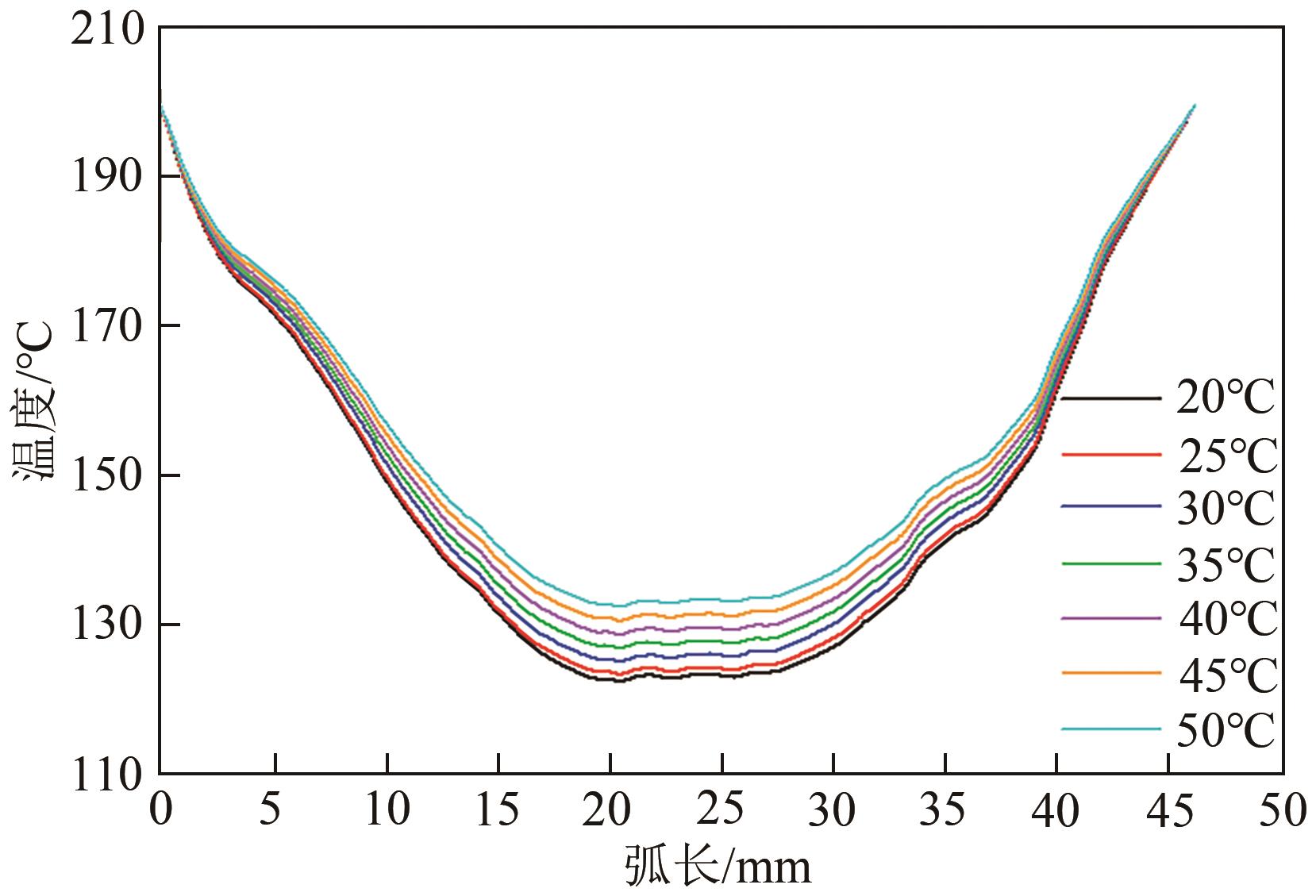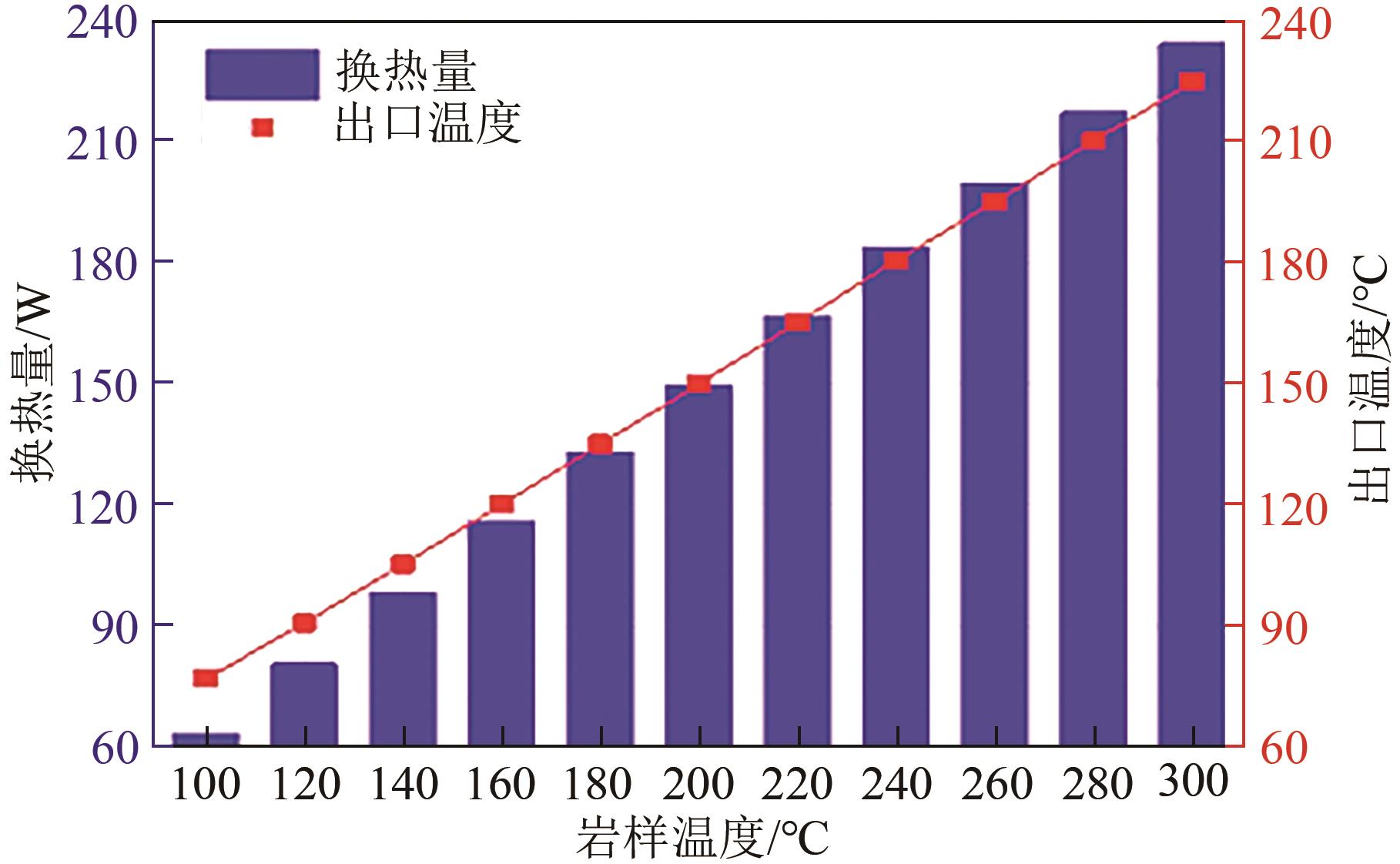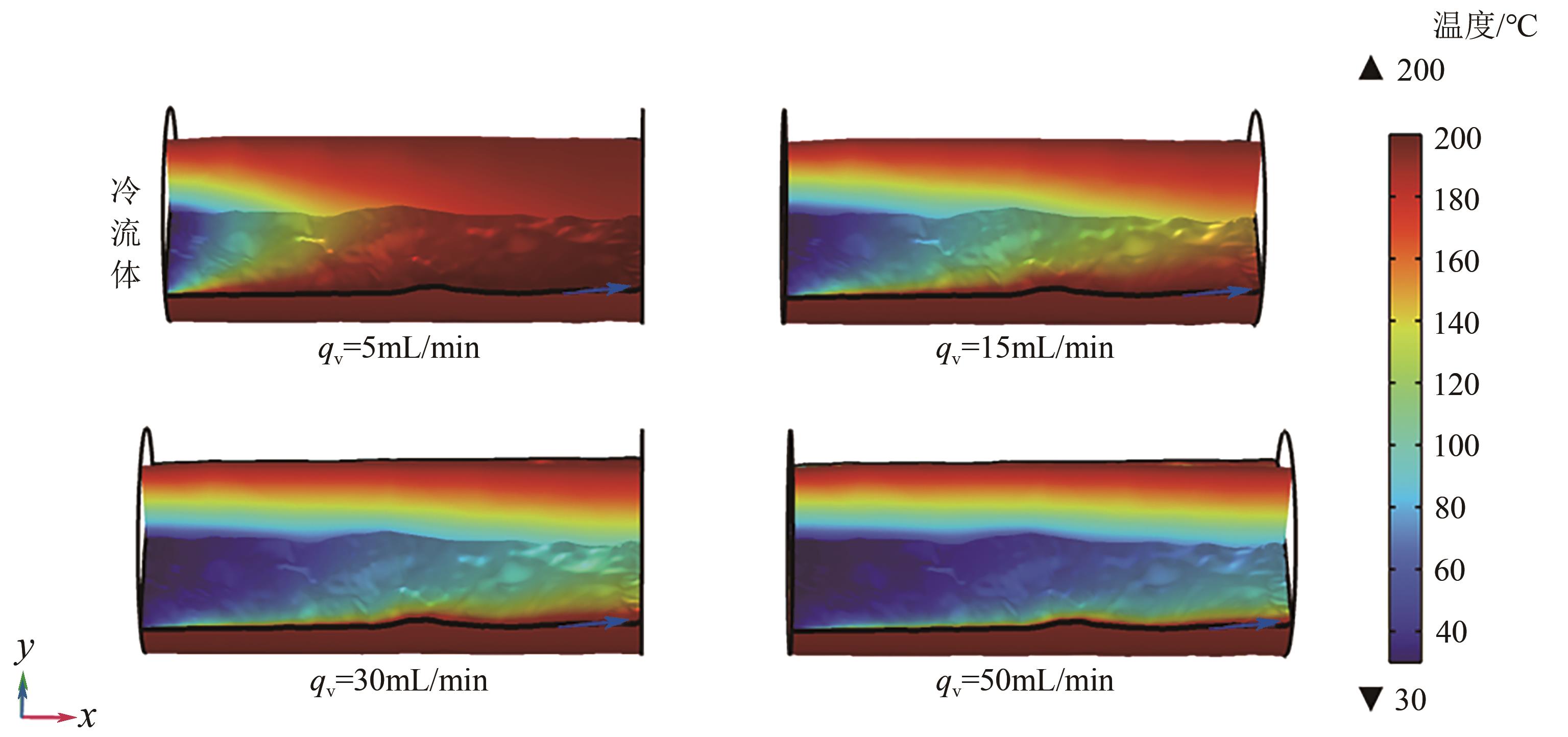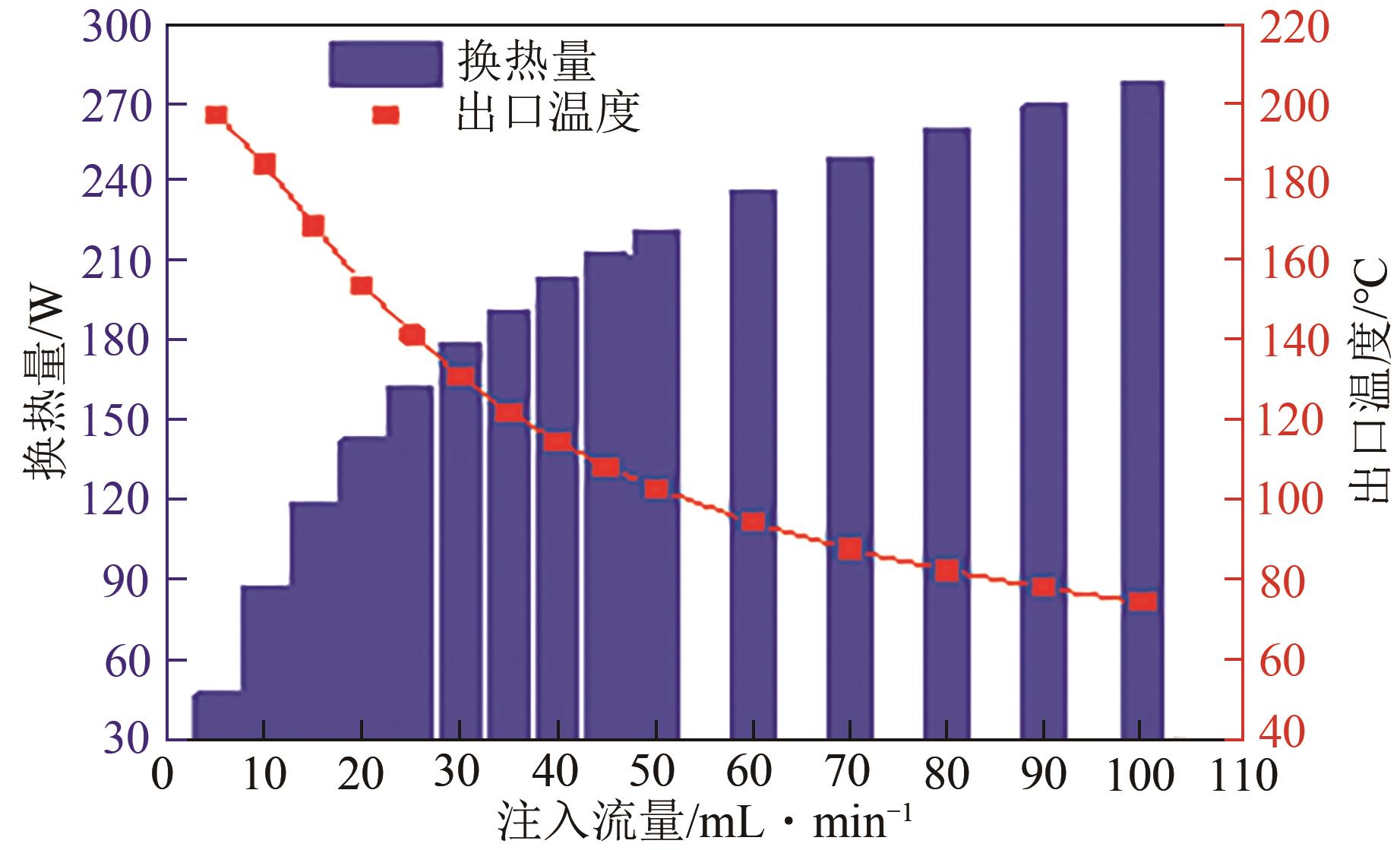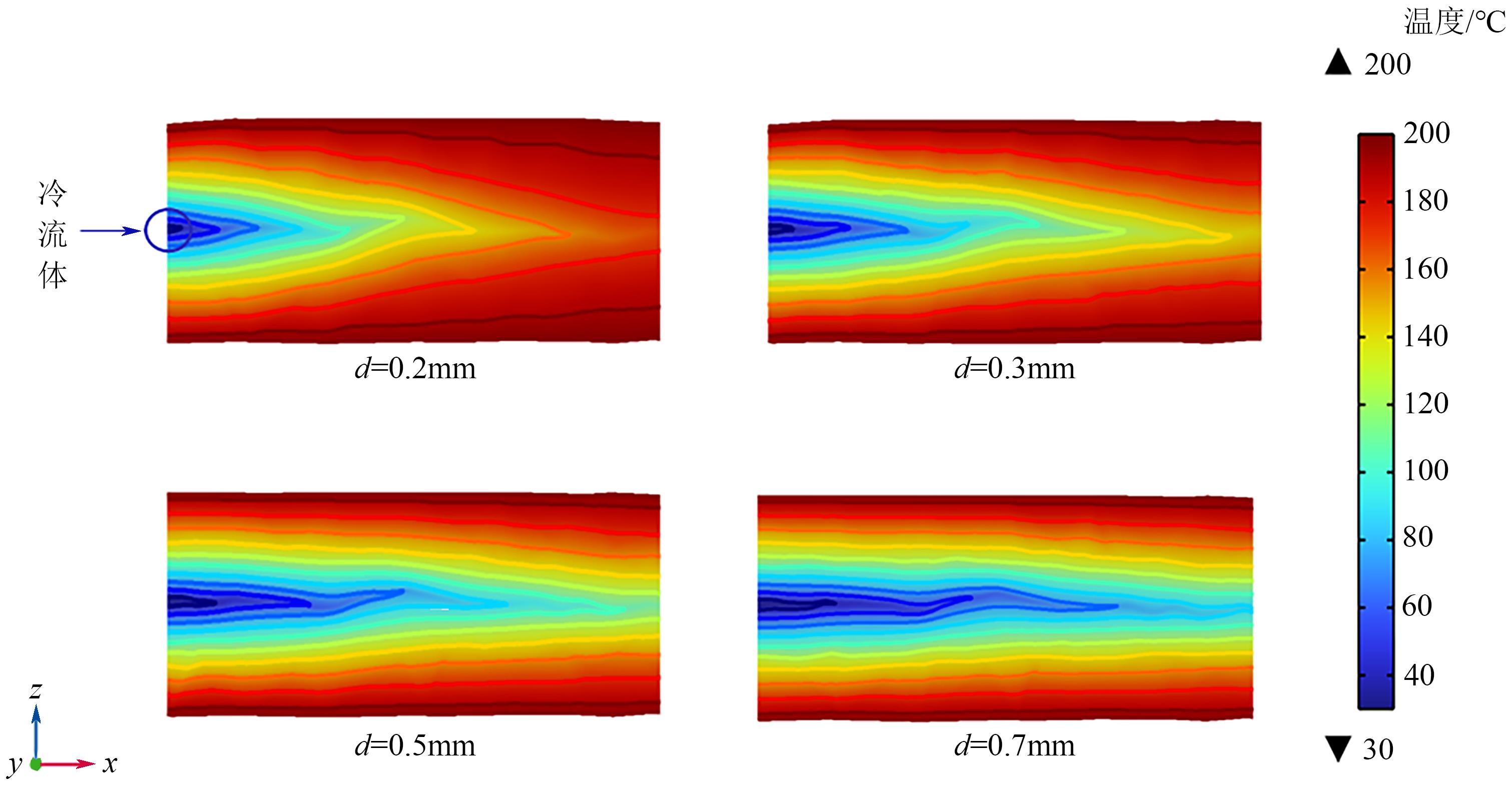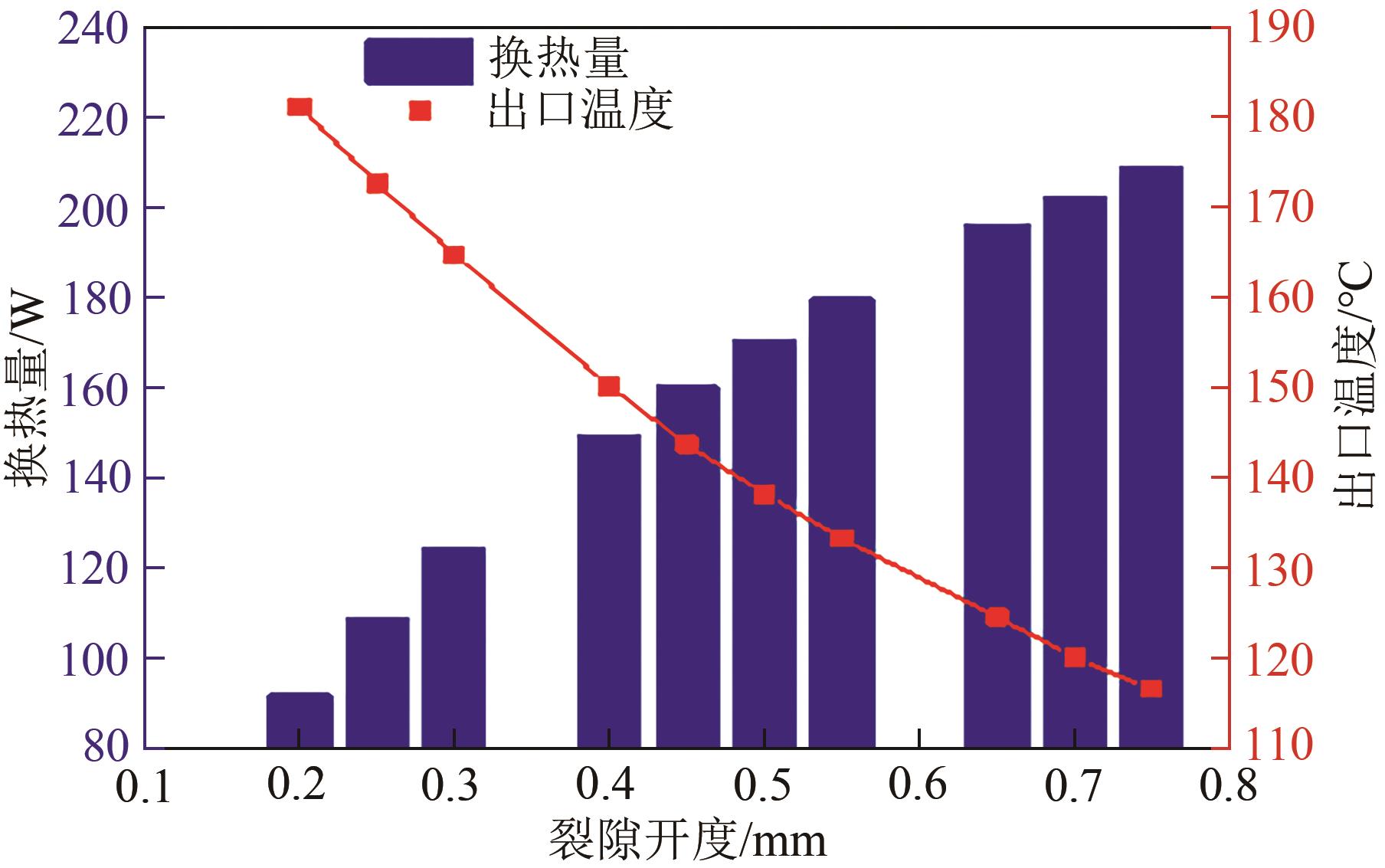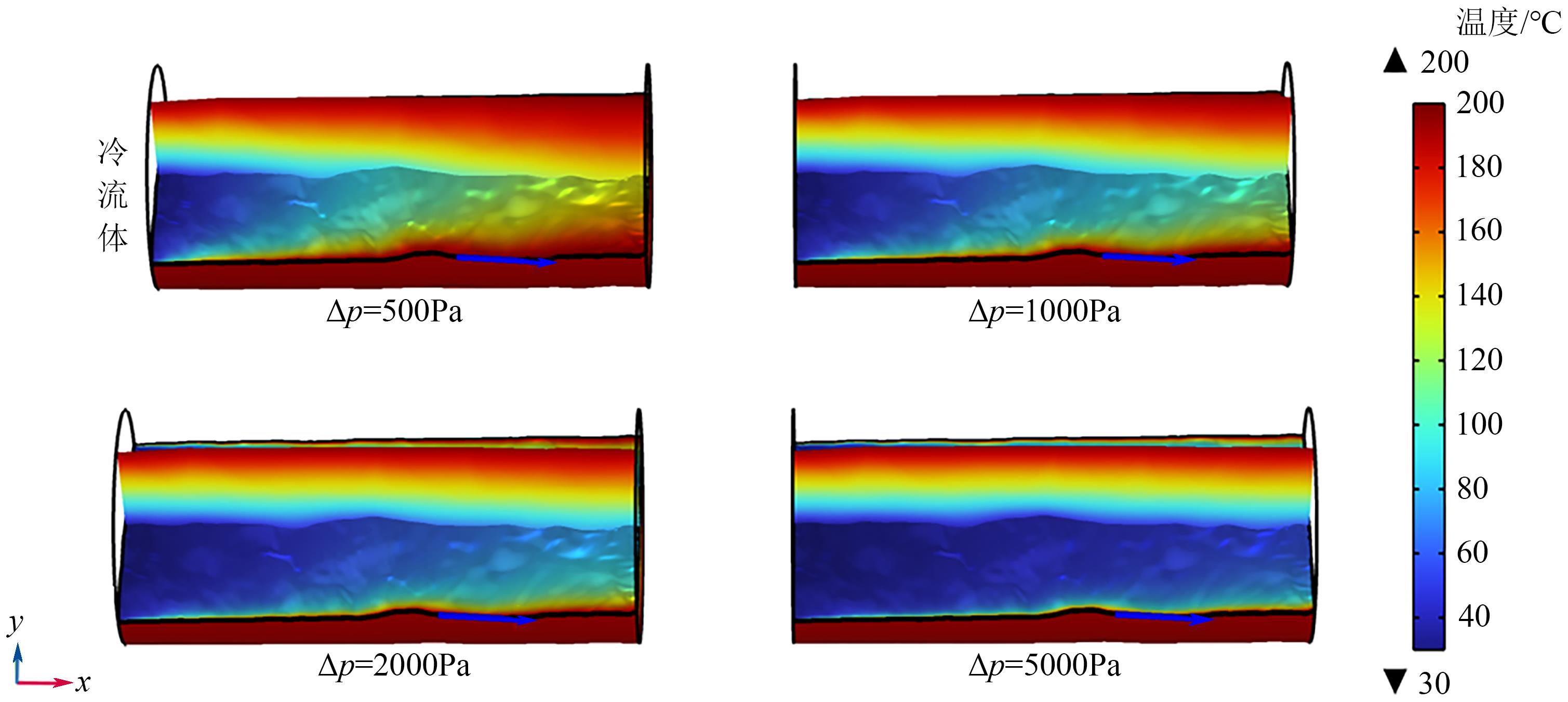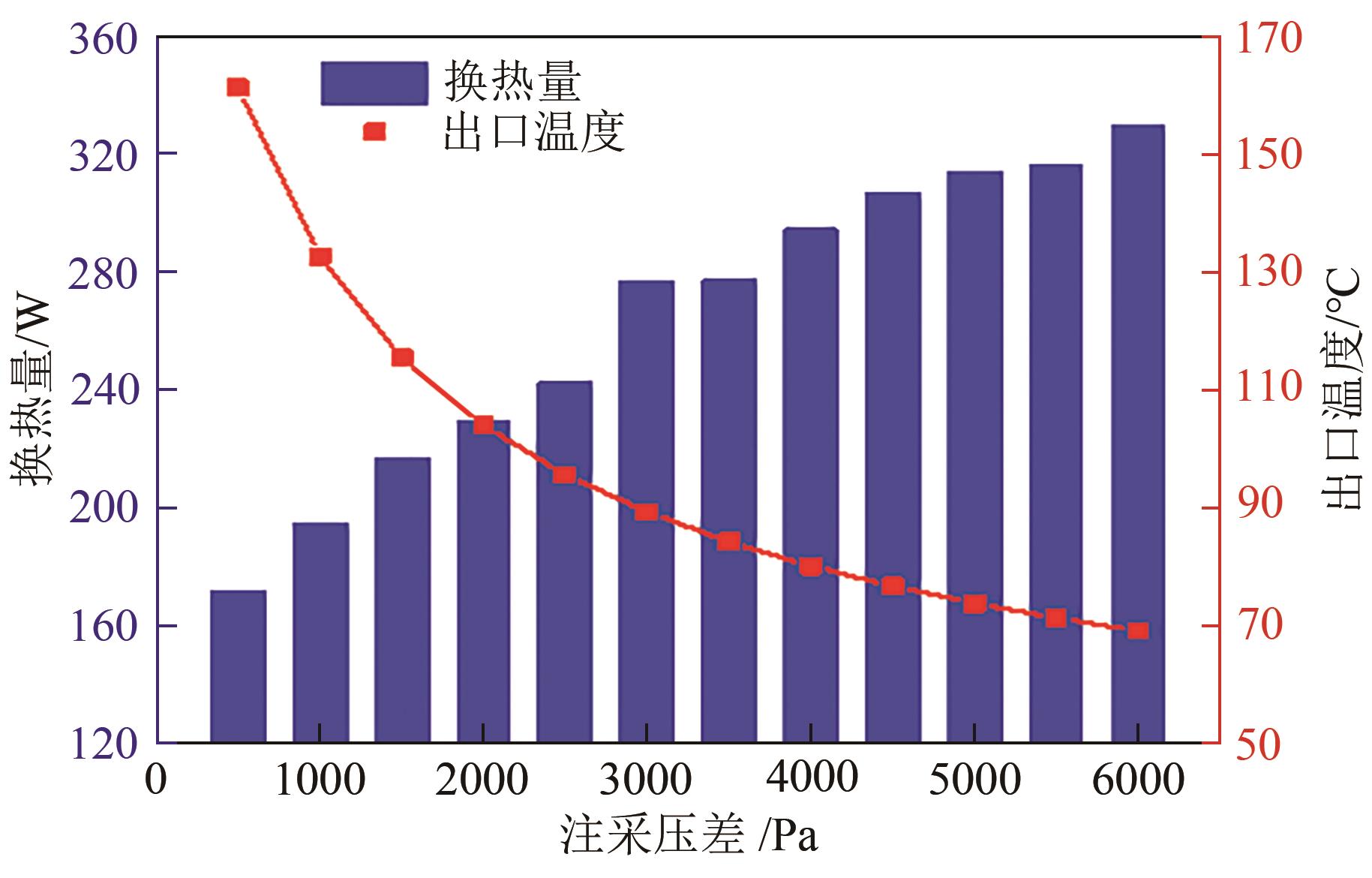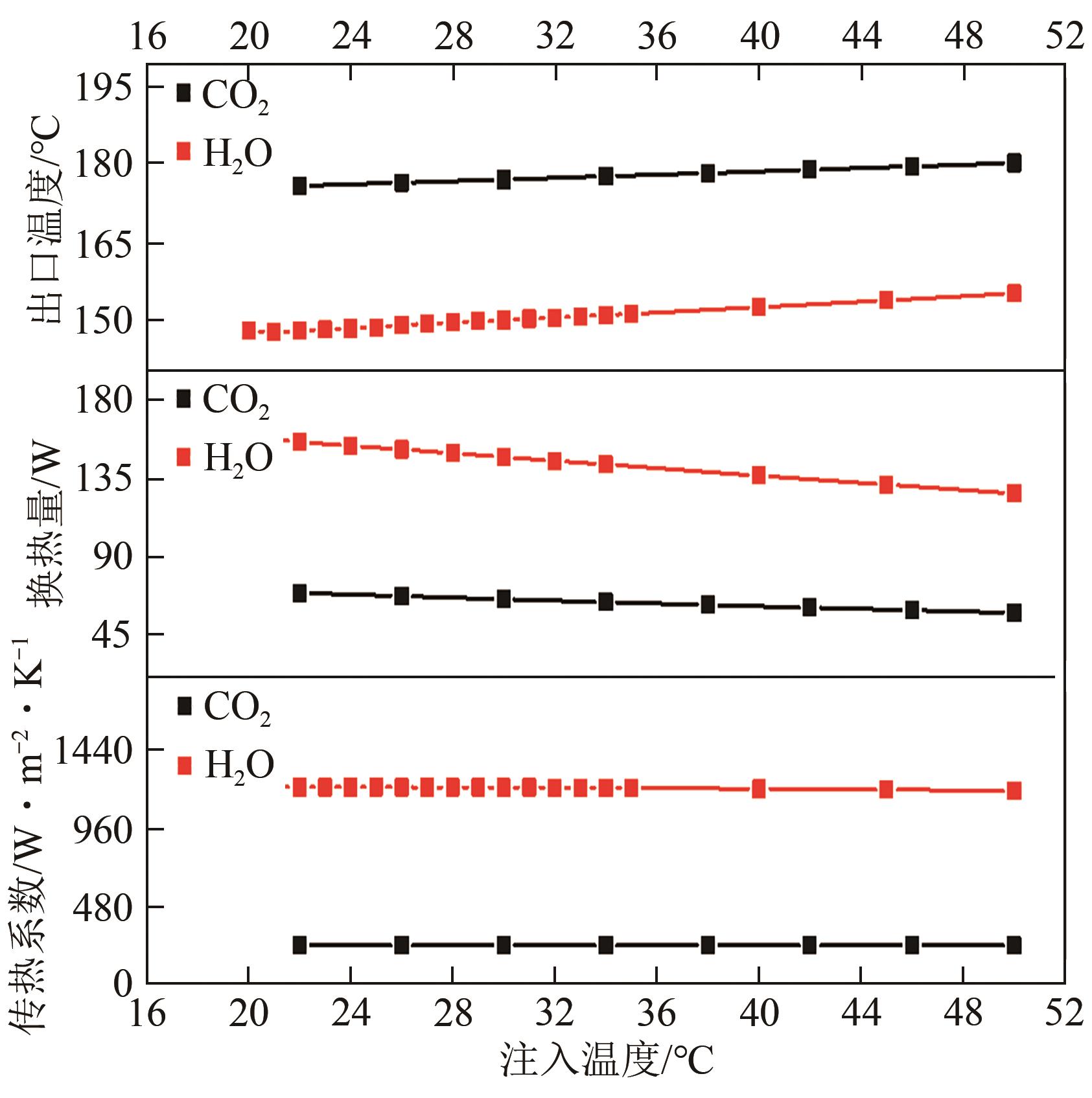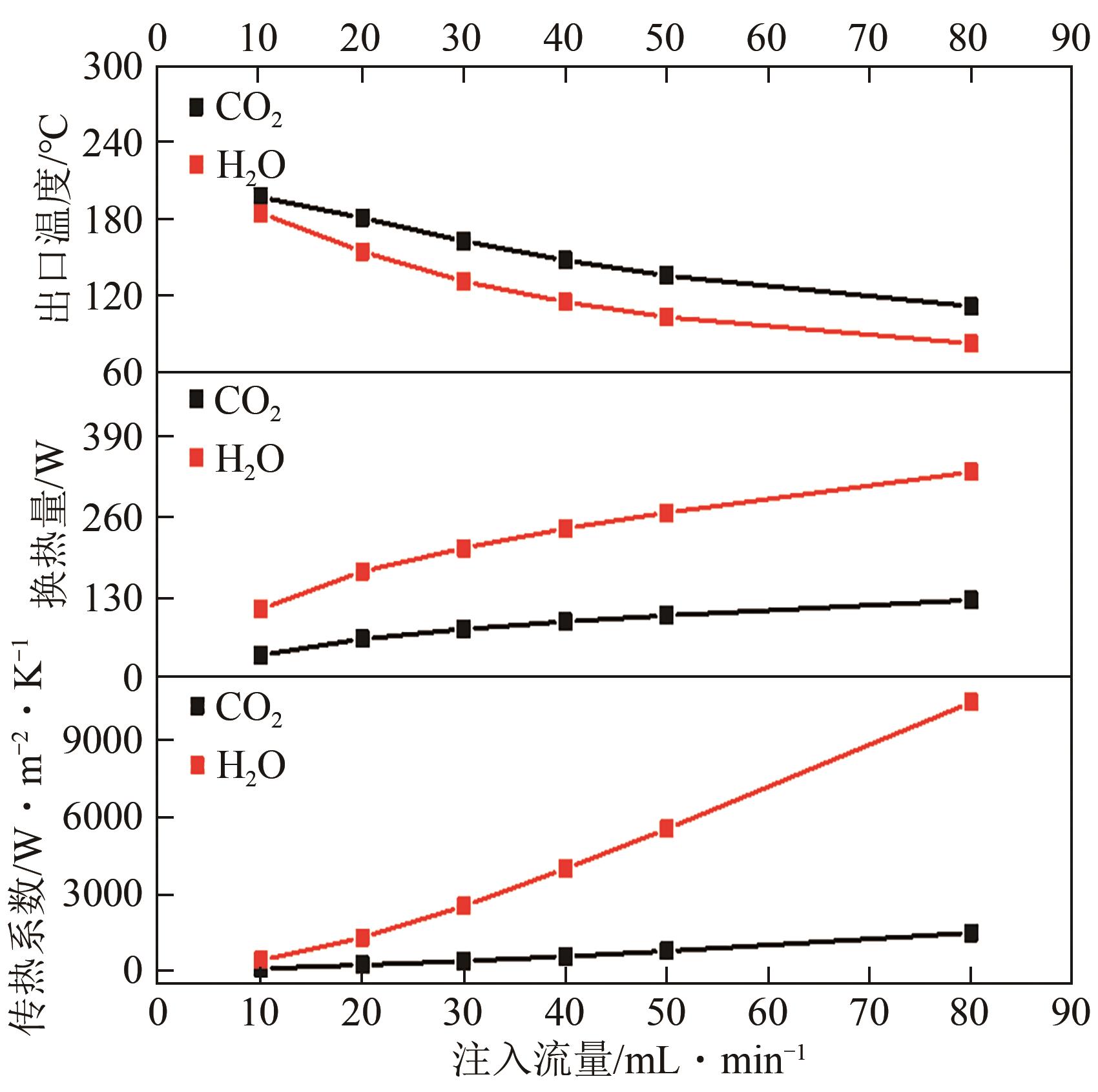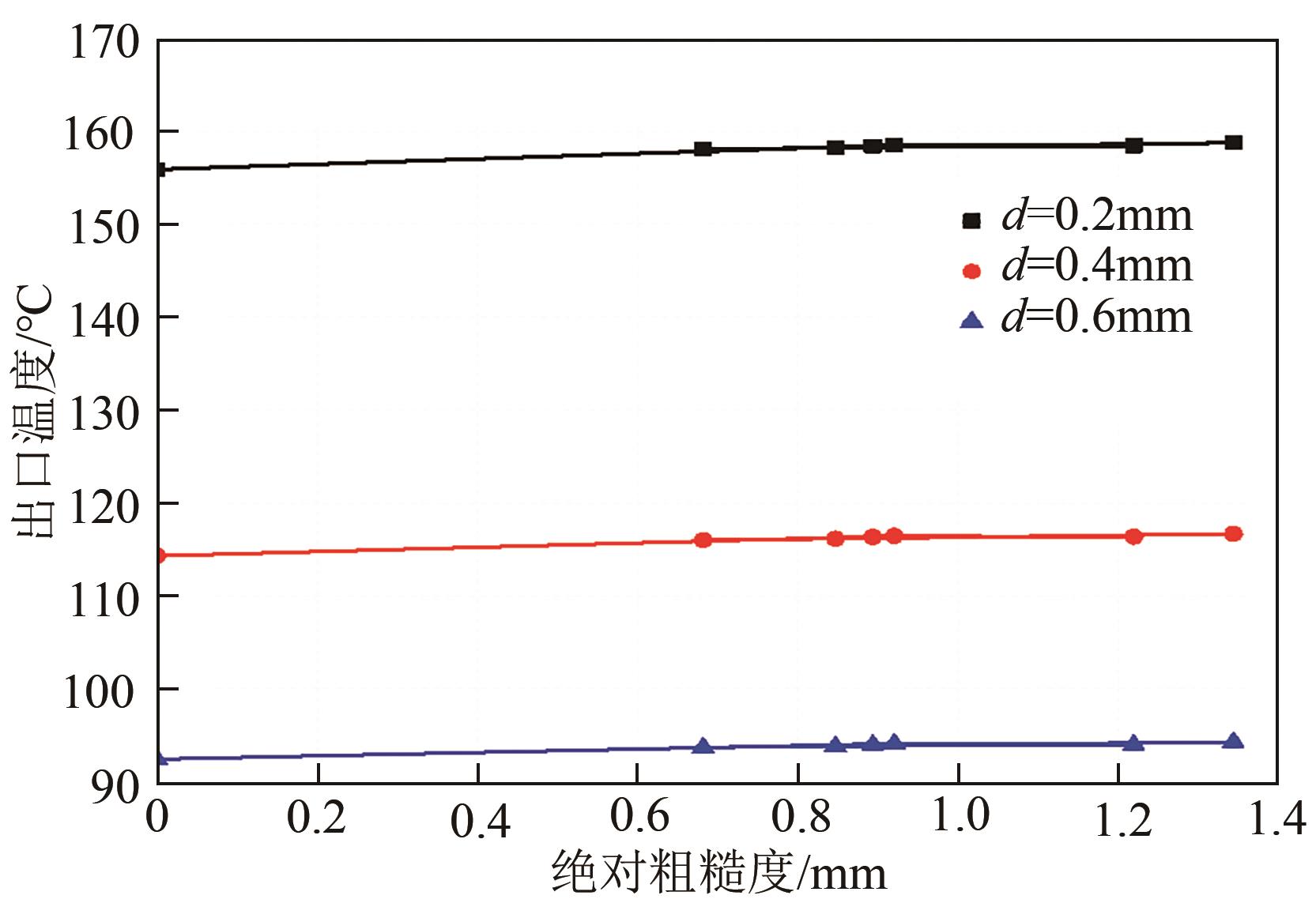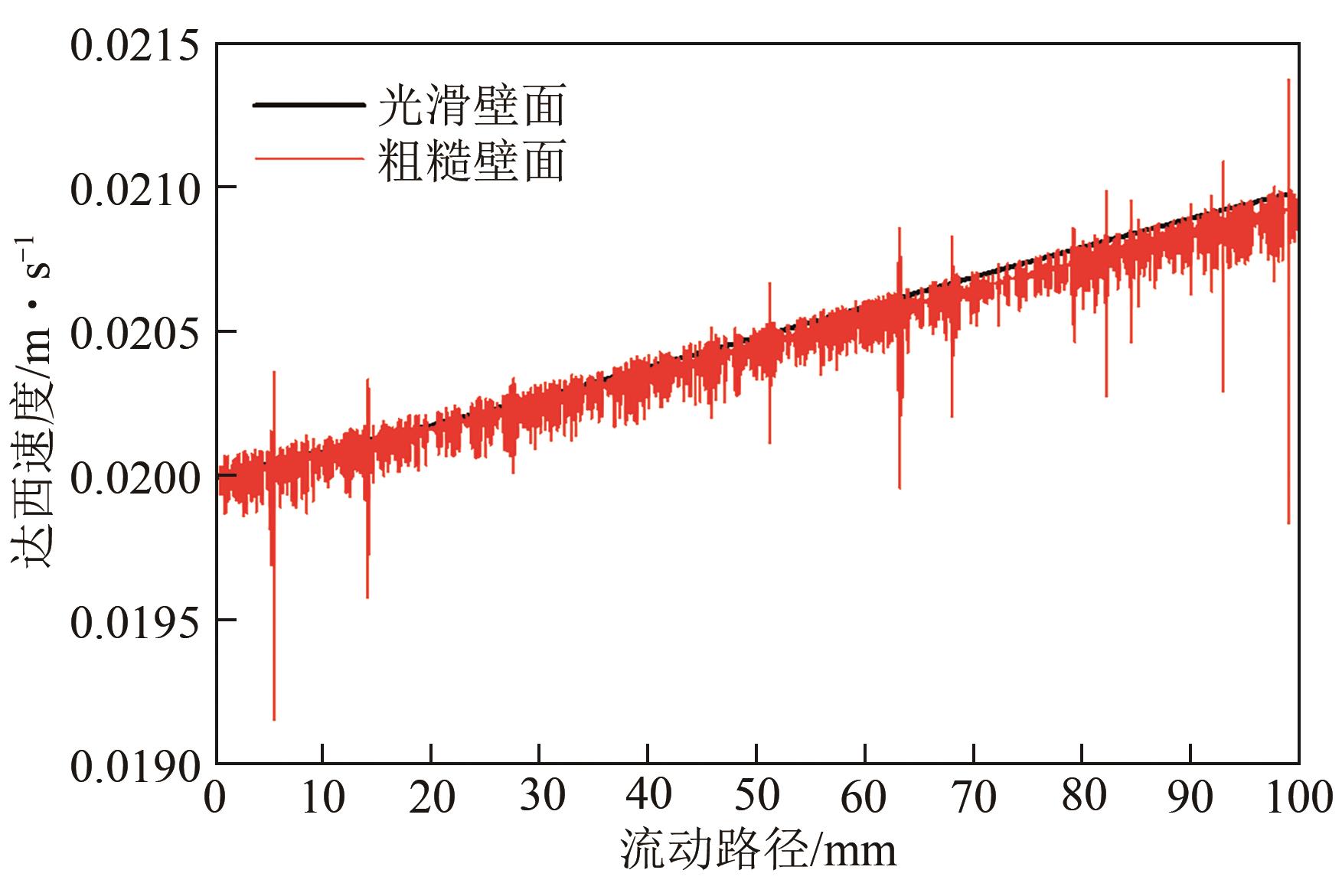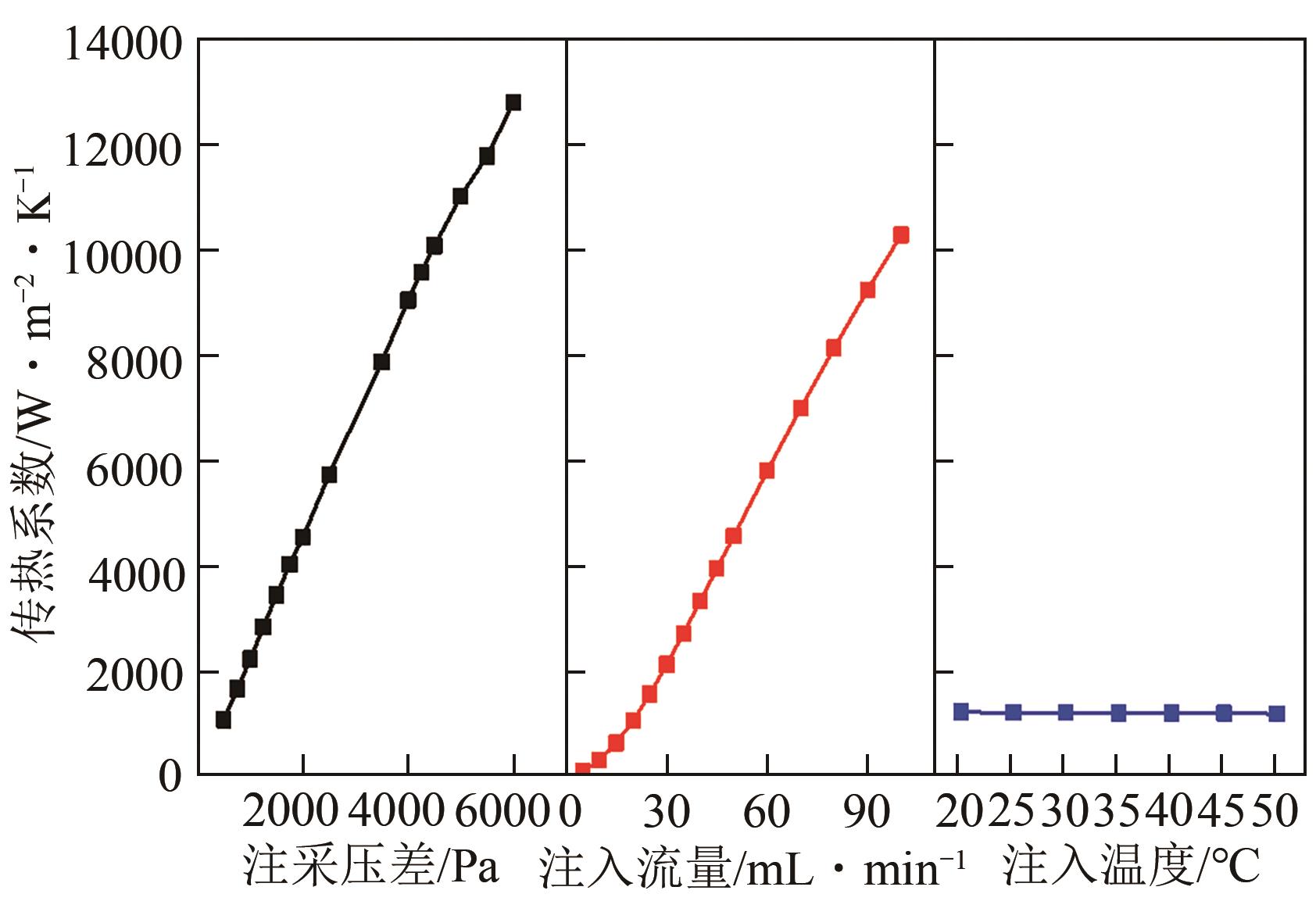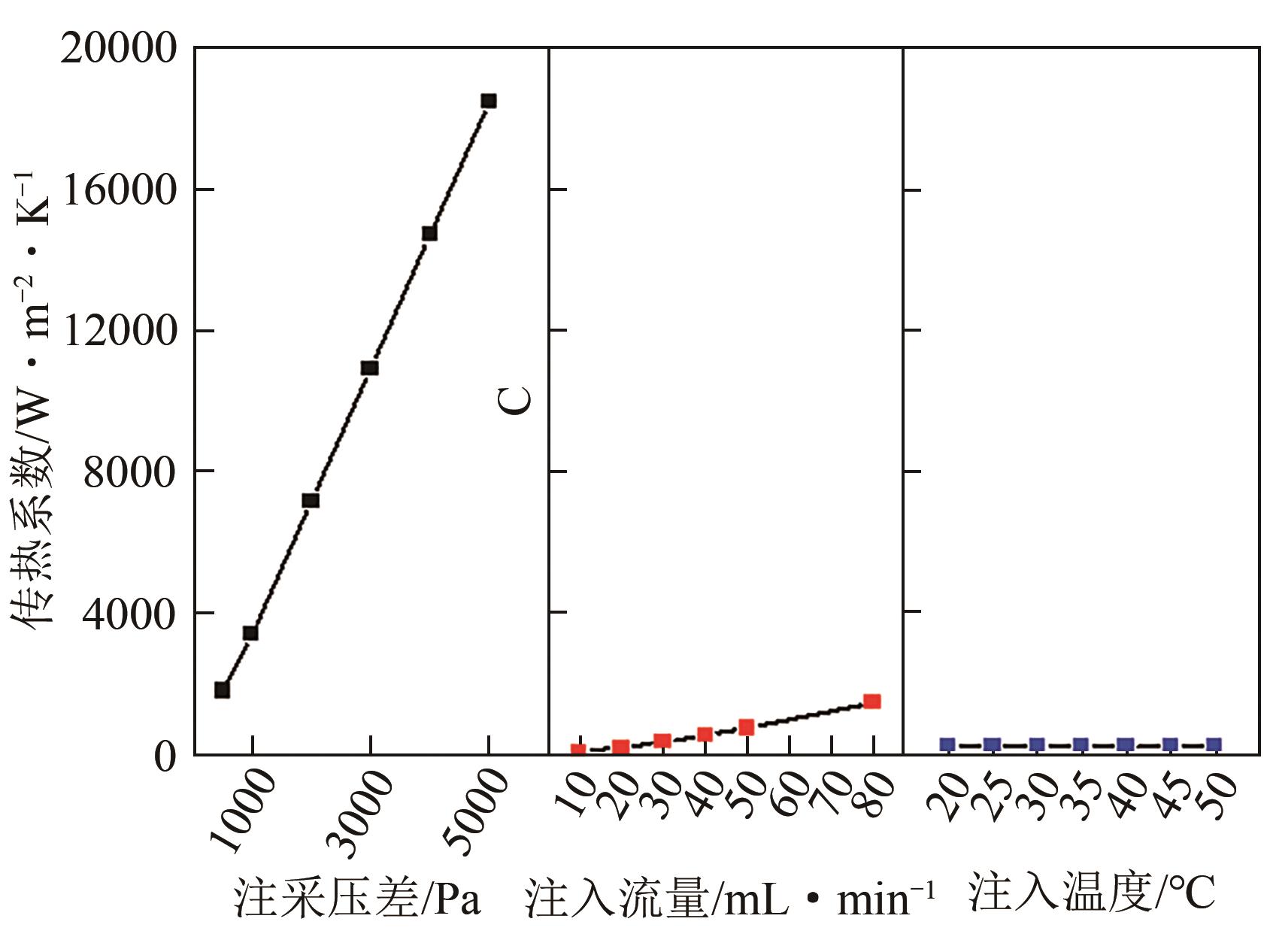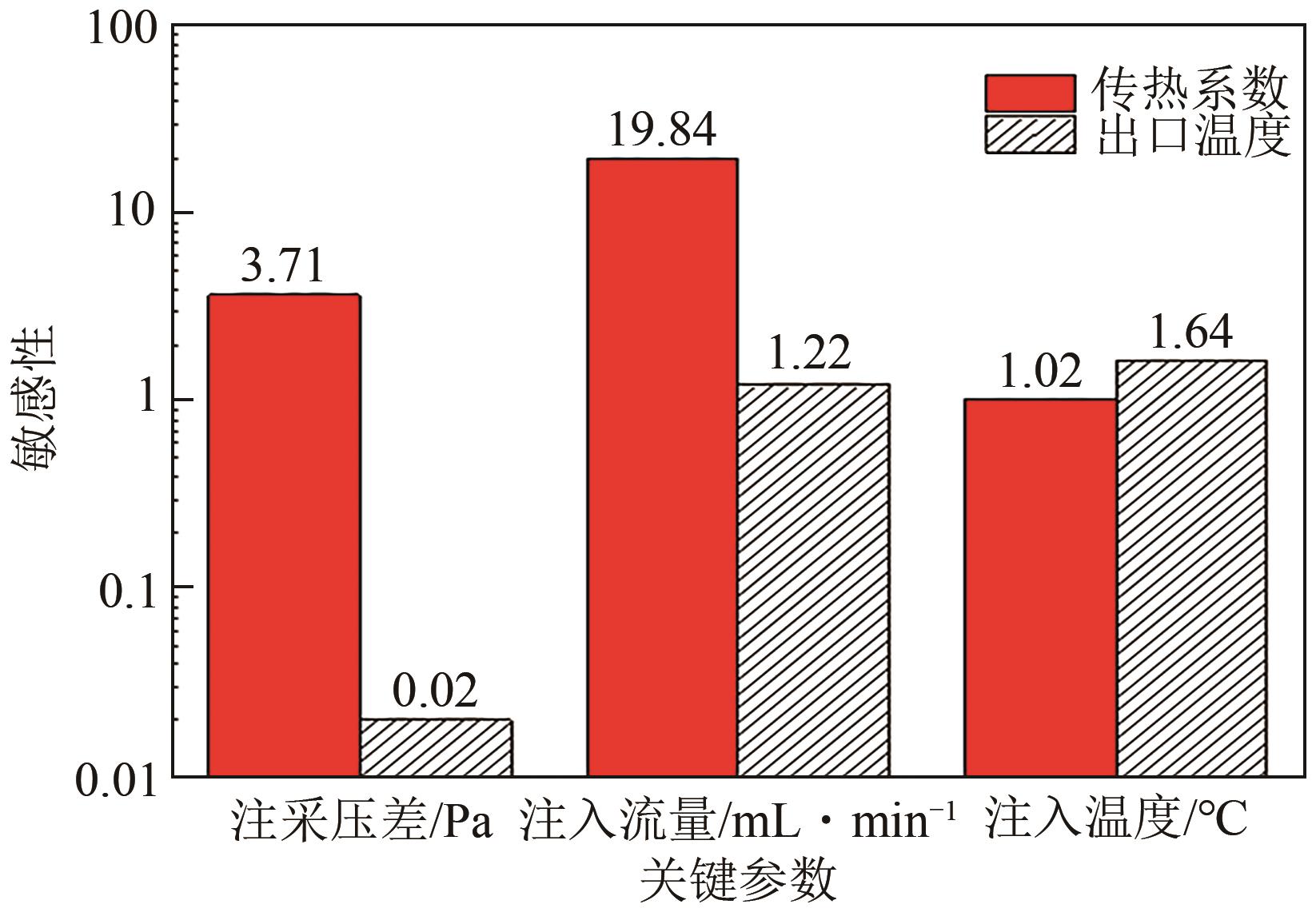化工进展 ›› 2024, Vol. 43 ›› Issue (10): 5403-5414.DOI: 10.16085/j.issn.1000-6613.2023-1659
• 化工过程与装备 • 上一篇
水和CO2在真实粗糙岩样单裂隙内对流传热的仿真分析
- 中国石油大学(北京)机械与储运工程学院,北京 102249
-
收稿日期:2023-09-19修回日期:2023-11-21出版日期:2024-10-15发布日期:2024-10-29 -
通讯作者:王吉 -
作者简介:王吉(1989—),男,博士,副教授,博士生导师,研究方向为微尺度相变换热。E-mail:wangji@cup.edu.cn。 -
基金资助:国家自然科学基金重大项目(52192623);国家自然科学基金(52006242)
Simulation of CO2 and water convective heat transfer in single fracture of practical rock sample
WANG Ji( ), LI Pujiang, ZHANG Ting, ZHU Chenyang, ZHANG Yuning
), LI Pujiang, ZHANG Ting, ZHU Chenyang, ZHANG Yuning
- College of Mechaical and Transportation Engineering, China University of Petroleum (Beijing), Beijing 102249, China
-
Received:2023-09-19Revised:2023-11-21Online:2024-10-15Published:2024-10-29 -
Contact:WANG Ji
摘要:
向高温地质裂缝内注入冷流体进行流动取热是目前地热开发常用的一种方式。增强型地热系统中的流体多在粗糙不规律的岩石裂隙中流动换热。为研究流体的传热量,基于青海共和盆地恰卜恰干热岩储层,通过扫描获得真实的单裂隙三维形貌。采用有限元三维仿真模拟建立真实准确的单裂隙流动传热数值模型。对比分析了注入温度、注入流量、初始岩样温度、裂隙开度和注采压差对水和二氧化碳传热效果的影响。研究结果表明:流体与岩样之间的温差越大,换热效果越好,流体的出口温度越低;流体注入流量、裂隙开度及注采压差越大,换热效果越好,流体的出口温度越低;运行参数对换热效果的影响程度由高到低依次是注入流量、注采压差、注入温度。将注入流量从10mL/min提高至80mL/min,以水作为取热工质的取热量由109W提高至351.2W,注入流量每提高1mL/min传热系数提高140.61W/(m2·K);以二氧化碳作为取热工质的取热量由36.9W提高至126.6W,注入流量每提高1mL/min传热系数提高19.84W/(m2·K),具有较高比热容和热导率的水会携带更多的热量,换热效果更强。
中图分类号:
引用本文
王吉, 李普江, 张婷, 朱晨阳, 张宇宁. 水和CO2在真实粗糙岩样单裂隙内对流传热的仿真分析[J]. 化工进展, 2024, 43(10): 5403-5414.
WANG Ji, LI Pujiang, ZHANG Ting, ZHU Chenyang, ZHANG Yuning. Simulation of CO2 and water convective heat transfer in single fracture of practical rock sample[J]. Chemical Industry and Engineering Progress, 2024, 43(10): 5403-5414.
| 参数 | 数值 |
|---|---|
| 岩石密度/kg·m-3 | 2650 |
| 岩石比热容/J·kg-1·k-1 | 1000 |
| 岩石热导率/W·m-1·k-1 | 2.8 |
| 岩石渗透率/m2 | 1×10-15 |
| 岩石孔隙度 | 0.01 |
| 岩石初始温度/℃ | 200 |
| 注入流速/ mL·min-1 | 20 |
表1 裂隙流动换热模型计算参数
| 参数 | 数值 |
|---|---|
| 岩石密度/kg·m-3 | 2650 |
| 岩石比热容/J·kg-1·k-1 | 1000 |
| 岩石热导率/W·m-1·k-1 | 2.8 |
| 岩石渗透率/m2 | 1×10-15 |
| 岩石孔隙度 | 0.01 |
| 岩石初始温度/℃ | 200 |
| 注入流速/ mL·min-1 | 20 |
| 开度 /μm | 注入流速 /mm·s-1 | 注入温度 /℃ | 出口温度/℃ | ||
|---|---|---|---|---|---|
| 实验数据 | 模拟数据 | 相对误差/% | |||
| 19.17 | 10.63 | 42 | 87 | 89.88 | 3.31 |
| 15.31 | 42 | 87 | 89.83 | 3.26 | |
| 20.52 | 41 | 87 | 89.76 | 3.17 | |
| 25.54 | 40 | 87 | 89.67 | 3.07 | |
| 30.08 | 39 | 87 | 89.57 | 2.95 | |
| 50.26 | 37 | 87 | 87.09 | 2.11 | |
| 76.46 | 34 | 87 | 87.10 | 0.11 | |
| 24.66 | 21.06 | 41 | 88 | 89.63 | 1.85 |
| 28.21 | 40 | 88 | 89.39 | 1.58 | |
| 35.20 | 38 | 88 | 89.04 | 1.18 | |
| 49.20 | 36 | 88 | 88.06 | 0.07 | |
表2 模拟数据与文献实验数据的对比
| 开度 /μm | 注入流速 /mm·s-1 | 注入温度 /℃ | 出口温度/℃ | ||
|---|---|---|---|---|---|
| 实验数据 | 模拟数据 | 相对误差/% | |||
| 19.17 | 10.63 | 42 | 87 | 89.88 | 3.31 |
| 15.31 | 42 | 87 | 89.83 | 3.26 | |
| 20.52 | 41 | 87 | 89.76 | 3.17 | |
| 25.54 | 40 | 87 | 89.67 | 3.07 | |
| 30.08 | 39 | 87 | 89.57 | 2.95 | |
| 50.26 | 37 | 87 | 87.09 | 2.11 | |
| 76.46 | 34 | 87 | 87.10 | 0.11 | |
| 24.66 | 21.06 | 41 | 88 | 89.63 | 1.85 |
| 28.21 | 40 | 88 | 89.39 | 1.58 | |
| 35.20 | 38 | 88 | 89.04 | 1.18 | |
| 49.20 | 36 | 88 | 88.06 | 0.07 | |
| 1 | 雷治红. 青海共和盆地干热岩储层特征及压裂试验模型研究[D]. 长春: 吉林大学, 2020. |
| LEI Zhihong. Study on reservoir characteristics and fracturing test model of dry-hot rocks in Gonghe Basin, Qinghai Province[D]. Changchun: Jilin University, 2020. | |
| 2 | ZHANG Le, JIANG Peixue, WANG Zhenchuan, et al. Convective heat transfer of supercritical CO2 in a rock fracture for enhanced geothermal systems[J]. Applied Thermal Engineering, 2017, 115: 923-936. |
| 3 | NIKHIL BAGALKOT, SURESH KUMAR G. Thermal front propagation in variable aperture fracture-matrix system: A numerical study[J]. Sadhana, 2015, 40(2): 605-622. |
| 4 | HE Yuanyuan, BAI Bing, HU Shaobin, et al. Effects of surface roughness on the heat transfer characteristics of water flow through a single granite fracture[J]. Computers and Geotechnics, 2016, 80: 312-321. |
| 5 | DE LA BERNARDIE J, BOUR O, LE BORGNE T, et al. Thermal attenuation and lag time in fractured rock: Theory and field measurements from joint heat and solute tracer tests[J]. Water Resources Research, 2018, 54(12): 10053-10075. |
| 6 | SONG Xianzhi, SHI Yu, LI Gensheng, et al. Numerical simulation of heat extraction performance in enhanced geothermal system with multilateral wells[J]. Applied Energy, 2018, 218: 325-337. |
| 7 | SHI Yu, SONG Xianzhi, LI Jiacheng, et al. Numerical investigation on heat extraction performance of a multilateral-well enhanced geothermal system with a discrete fracture network[J]. Fuel, 2019, 244: 207-226. |
| 8 | LUO Yinfei, XU Weilin, LEI Yude, et al. Experimental study of heat transfer by water flowing through smooth and rough rock fractures[J]. Energy Reports, 2019, 5: 1025-1029. |
| 9 | YAO Chi, SHAO Yulong, YANG Jianhua, et al. Effects of fracture density, roughness, and percolation of fracture network on heat-flow coupling in hot rock masses with embedded three-dimensional fracture network[J]. Geothermics, 2020, 87: 101846. |
| 10 | 惠峥, 冯子军, 武治盛, 等. 多级围压下砂岩单裂隙渗流传热试验研究[J]. 矿业研究与开发, 2020, 40(9): 105-110. |
| HUI Zheng, FENG Zijun, WU Zhisheng, et al. Experimental study on seepage and heat transfer of sandstone with single fracture under multi-level confining pressure[J]. Mining Research and Development, 2020, 40(9): 105-110. | |
| 11 | 肖鹏, 窦斌, 田红, 等. 地热储层单裂隙岩体渗流传热数值模拟研究[J]. 钻探工程, 2021, 48(2): 16-28. |
| XIAO Peng, DOU Bin, TIAN Hong, et al. Numerical simulation of seepage and heat transfer in single fractured rock mass of geothermal reservoirs[J]. Drilling Engineering, 2021, 48(2): 16-28. | |
| 12 | 张博, 曲占庆, 郭天魁, 等. 粗糙单裂隙换热特征及全局灵敏度分析研究[J]. 地球物理学进展, 2022, 37(4): 1520-1527. |
| ZHANG Bo, QU Zhanqing, GUO Tiankui, et al. Study on heat transfer characteristics and global sensitivity analysis of a rough single fracture[J]. Progress in Geophysics, 2022, 37(4): 1520-1527. | |
| 13 | 单丹丹, 闫铁, 李玮, 等. 单裂隙热储热流耦合数值模拟分析[J]. 当代化工, 2020, 49(4): 716-719, 723. |
| SHAN Dandan, YAN Tie, LI Wei, et al. Numerical simulation and analysis of thermal-hydraulic coupling in a single-fracture thermal reservoir[J]. Contemporary Chemical Industry, 2020, 49(4): 716-719, 723. | |
| 14 | ZHANG Ze, WANG Shuhong, YANG Tianjiao, et al. A fully coupled seepage-heat transfer model including a dynamic heat transfer coefficient in fractured rock sample with a single fissure[J]. Geomatics, Natural Hazards and Risk, 2021, 12(1): 2253-2276. |
| 15 | SONG Guofeng, SONG Xianzhi, XU Fuqiang, et al. Numerical parametric investigation of thermal extraction from the enhanced geothermal system based on the thermal-hydraulic-chemical coupling model[J]. Journal of Cleaner Production, 2022, 352: 131609. |
| 16 | SPAN Roland, WAGNER Wolfgang. A new equation of state for carbon dioxide covering the fluid region from the triple-point temperature to 1100 K at pressures up to 800MPa[J]. Journal of Physical and Chemical Reference Data, 1996, 25(6): 1509-1596. |
| 17 | HUBER M L, SYKIOTI E A, ASSAEL M J, et al. Reference correlation of the thermal conductivity of carbon dioxide from the triple point to 1100K and up to 200MPa[J]. Journal of Physical and Chemical Reference Data, 2016, 45(1): 013102. |
| 18 | ARNO Laesecke, MUZNY Chris D. Reference correlation for the viscosity of carbon dioxide[J]. Journal of Physical and Chemical Reference Data, 2017, 46: 013107. |
| 19 | 李裴晨, 张慢来, 黄新宇, 等. 超临界二氧化碳热物性参数计算研究[J]. 内江科技, 2020, 41(1): 79-80. |
| LI Peichen, ZHANG Manlai, HUANG Xinyu, et al. Study on calculation of thermophysical parameters of supercritical carbon dioxide[J]. Nei Jiang Science & Technology, 2020, 41(1): 79-80. | |
| 20 | 司杨, 张学林, 梅生伟, 等. 干热岩发电技术及青海共和干热岩应用初探[J]. 全球能源互联网, 2018, 1(3): 322-329. |
| SI Yang, ZHANG Xuelin, MEI Shengwei, et al. Exploration of hot dry rock power generation technology and application in Qinghai Gonghe Basin[J]. Journal of Global Energy Interconnection, 2018, 1(3): 322-329. | |
| 21 | 许天福, 袁益龙, 姜振蛟, 等. 干热岩资源和增强型地热工程: 国际经验和我国展望[J]. 吉林大学学报(地球科学版), 2016, 46(4): 1139-1152. |
| XU Tianfu, YUAN Yilong, JIANG Zhenjiao, et al. Hot dry rock and enhanced geothermal engineering: International experience and China prospect[J]. Journal of Jilin University (Earth Science Edition), 2016, 46(4): 1139-1152. | |
| 22 | PARK Eui-Seob. Case studies of enhanced geothermal system: Fenton hill in USA and hijiori in Japan[J]. Journal of Korean Society for Rock Mechanics, 2013, 23(6): 547-560. |
| 23 | KELKAR Sharad, WOLDEGABRIEL Giday, REHFELDT Kenneth. Lessons learned from the pioneering hot dry rock project at Fenton Hill, USA[J]. Geothermics, 2016, 63: 5-14. |
| [1] | 李依梦, 陈运全, 何畅, 张冰剑, 陈清林. 基于物理信息神经网络的甲烷无氧芳构化反应的正反问题[J]. 化工进展, 2024, 43(9): 4817-4823. |
| [2] | 崔祎, 李孟原, 杨路, 李海东, 张奇琪, 常承林, 王彧斐. 采用扭曲片内插件的管壳式换热器自动设计新方法[J]. 化工进展, 2024, 43(9): 4824-4832. |
| [3] | 廖旭, 周骏, 罗杰, 曾瑞琳, 王泽宇, 李尊华, 林金清. 多孔离子聚合物催化二氧化碳环加成反应的研究进展[J]. 化工进展, 2024, 43(9): 4925-4940. |
| [4] | 曹树扬, 施静波, 董友明, 吕建雄. 不同温度下斜叶桉木材吸湿、解吸等温线与热力学性质[J]. 化工进展, 2024, 43(9): 5095-5105. |
| [5] | 王亚男, 刘琳琳, 庄钰, 都健. 基于代理模型的环氧乙烷制乙二醇工艺优化同步热集成[J]. 化工进展, 2024, 43(9): 5234-5241. |
| [6] | 郑庆雨, 金光远, 冯文凯, 朱正山, 周逸凡, 滕厚场, 李臻峰, 宋春芳, 宋飞虎, 李静. 一种混沌C型几何流动混合耦合电磁热特性数值分析[J]. 化工进展, 2024, 43(8): 4262-4272. |
| [7] | 谢娟, 贺文, 赵勖丞, 李帅辉, 卢真真, 丁哲宇. 分子动力学模拟在沥青体系中的应用研究进展[J]. 化工进展, 2024, 43(8): 4432-4449. |
| [8] | 怀立业, 仲兆平, 杨宇轩. 脱硫石膏转化α-半水石膏的特征及机理:实验与模拟[J]. 化工进展, 2024, 43(8): 4694-4703. |
| [9] | 郭长滨, 李蒙蒙, 冯梦晗, 原田, 张克强, 罗艳丽, 王风. 铈掺杂镧基钙钛矿制备及对水体磷酸盐和植酸的吸附性能[J]. 化工进展, 2024, 43(8): 4748-4756. |
| [10] | 蒋静智, 邵国伟, 崔海亭, 李洪涛, 杨奇. 三套管式加肋相变蓄热单元的强化传热特性[J]. 化工进展, 2024, 43(8): 4210-4221. |
| [11] | 王世伟, 王超, 郭琪, 丁红兵. 基于ECT模型修正及算法优化的超音速分离流场图像重建[J]. 化工进展, 2024, 43(8): 4222-4229. |
| [12] | 丁路, 王培尧, 孔令学, 白进, 于广锁, 李文, 王辅臣. 煤气化过程反应模型研究进展[J]. 化工进展, 2024, 43(7): 3593-3612. |
| [13] | 罗丛佳, 豆义波, 卫敏. 水滑石光催化剂结构调控用于二氧化碳还原的研究进展[J]. 化工进展, 2024, 43(7): 3891-3909. |
| [14] | 赵伟刚, 张倩倩, 蓝钰玲, 闫雯, 周晓剑, 范毜仔, 杜官本. 真空绝热板芯材的研究进展与展望[J]. 化工进展, 2024, 43(7): 3910-3922. |
| [15] | 唐安琪, 魏昕, 丁黎明, 王玉杰, 徐一潇, 刘轶群. 聚酰亚胺气体分离膜的物理老化现象浅析[J]. 化工进展, 2024, 43(7): 3923-3933. |
| 阅读次数 | ||||||
|
全文 |
|
|||||
|
摘要 |
|
|||||

